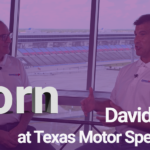Yesterday I had the pleasure of interviewing David Starr live in his trailer at Daytona International Speedway. Daytona is the best known of the NASCAR venues, not least because it was the first NASCAR race track, built-in 1959 by NASCAR’s founder Bill France. France introduced high banked turns to stock car racing, thus allowing for much faster speeds than had previously been possible. In fact, this weekend the cars will have restrictor plates to limit the amount of air and fuel that can be drawn into the engines. As David explained, this is to prevent cars from exceeding 207 miles per hour, this being for the safety of the drivers.
Until Wednesday, David and his team were in Statesville, North Carolina, preparing his vehicles for this weekend. This is where his racing team is based. He raced in the LTi Printing 250 Xfinity Race last Saturday at Michigan International Speedway and then flew directly to North Carolina the next day. I asked David how he copes with being away from his family and traveling all over the U.S. He replied, “that’s I guess the most challenging part of doing what we do.” He shared that when he met his wife, he was already a stock car racing driver. So, what he did before their marriage and what he does now is, in his words, “our normal – ever since I met her, our life’s been the same.” He joked about if he’s at home for more than a couple of weeks, “she’s kind of wondering when I’m leaving.”
Last evening, he drove his Toyota Camry in the Xfinity Series Race at Daytona. There was a crash during the 19th lap and the race will resume at 12:30 this afternoon. This evening, David is scheduled to drive his Toyota Supra in the Coke Zero Sugar 400 Cup Race. This will be a busy and exhausting weekend for him, and for his whole support team.
During our chat together, David went into detail about how he and his team prepare his cars, not least in the positioning of his seat, steering wheel, and equipment. For example, he prefers a more upright seated position compared to many of his peers.
David also told us about several of the safety features that have been introduced by NASCAR over the years. He talked about the soft walls now situated on the inside and the outside of all tracks. In years gone by, drivers might hit a solid concrete wall, 12 inches thick and four feet high. The force could be the equivalent of ten G’s. The soft walls are aluminum with expanded Styrofoam behind them. David talked about the ten G’s now being closer to four G’s, thus dramatically reducing the possibility of injury to a driver during a collision.
David talked about the death in February 2001 of Dale Earnhardt, a seven-time champion of NASCAR, and how over a nine-year time span, Earnhardt and eight other NASCAR drivers had died during accidents. David then described the HANS device (Head and Neck Support) that is connected to the driver’s helmet and supported by the driver’s own shoulders and body. David said that since the introduction of the HANS device, there have been no race fatalities. In David’s words, “people want to see the excitement and the fire and the sparks. But, you know, people don’t want to see [drivers] lose their lives.”
David has had such an amazing life, and I’m looking forward to our next conversation. Drop me a line at Neil@ConectUS.com with your questions for David Starr, or if you’d like me to email you with a link to more articles about David.


